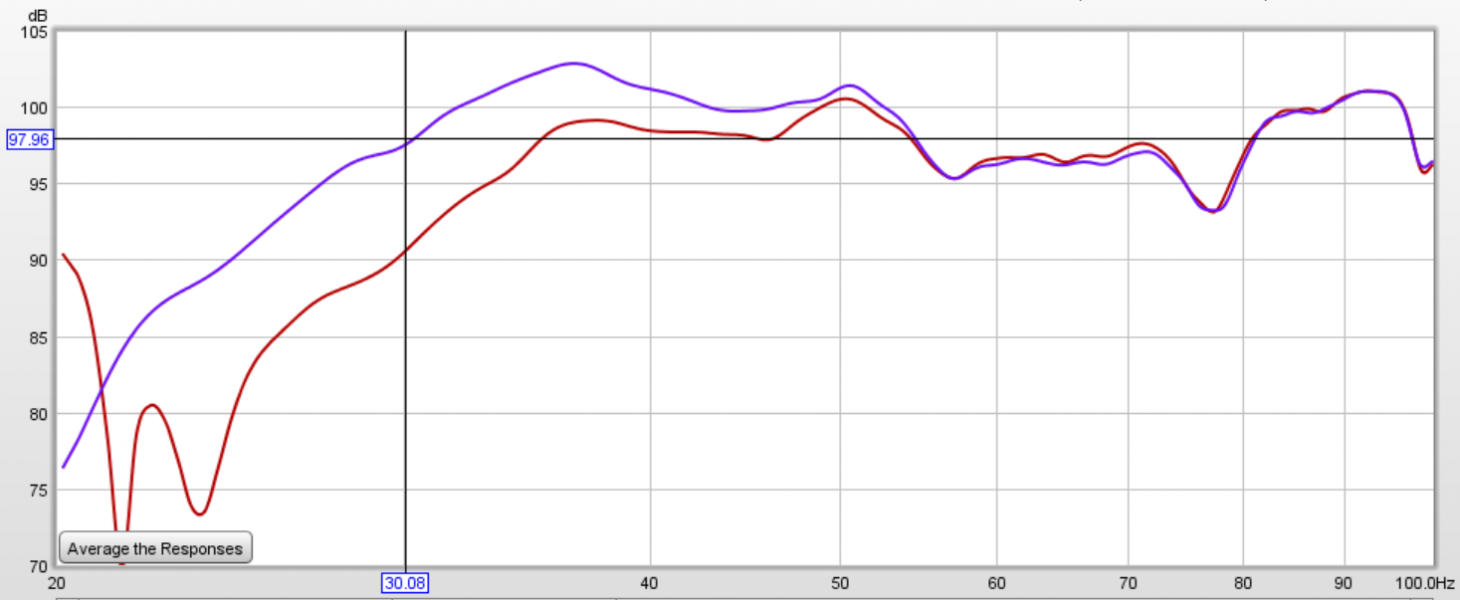I did not opt to put the speakers in the front of the room as the bass was too lumpy for me and there were a few other acoustic issues related to the main trio response in the front. Instead I have the speaker pulled very far into the room (about 13'). Here is the response of the spacehorn as it stands.

The bottom curve represents the spacehorn with no DSP applied. The top curve is after I played with the high-shelf filter option. Ignore the vertical scale as the value is not calibrated. All that matters for this is the shape and the relative difference between the two curves.
A few things to note. First is the cut-off frequency of 35Hz where the output starts dropping at about 24dB/Oct. (The "wiggles" we are seeing down at 20-25Hz are an artifact of the output being so low in level.) Again, this is what to expect without any boundary reinforcement. probably not many people will pull the horns this far from the wall.
I mentioned in the video that we could use a shelf filter to pull down the output above a certain level to get the bass flat. if you get into the actual DSP of the spacehorn (not the GUI) then it does have both low and high shelf filters. You can choose the frequency you want to start the shelf, the Q and the Gain. If you are not familiar with shelf filters then google will return links with lots of info on them.
I played with the various settings and what is pictured above is about the best I could get. I set the frequency to 35Hz and the gain to -9dB. The Q is at 15 (which is pretty high). With these settings it really raised the bass output from 35 to 55Hz. (Really, it lowered everything above this) You can see the levels above about 53Hz are very well matched. In the graph I placed the cursor at 30Hz. You can see that the level at 30Hz is about the same as up higher at 70-90Hz. So we have extended the bass output flat to 30Hz. It is -3dB at about 27Hz.
So I got flat bass down to 30Hz. What is needed to do this and could it be better? The basline curve (without DSP) is with the volume on the spacehorn set at -9.0. Recall that the spacehorn has a volume setting that ranges from -12 to +12. The iTron amp also has switches that let us adjust the overall gain of the 3 horns. i have the -3 and -6 switches engages meaning that the Trio is down by 9 dB and I use the preamp volume to get the level back up. I have the Spacehorn volume set at -9 to match the trios. What I did with the shelf filter is give it a gain of -9 so I simply turned the spacehorn up to 0. If I wanted to go into positive gain on the spacehorn I could turn it up another 6 or even 9. and I could have extended the bass output further into the lower 20's. I am not sure what this would have sounded like. If I start getting worried about the hump that is being created at 35Hz I could use a PEQ to pull that down.
Now, if I was not using the iTron amp and instead using some other amplifier -- Viva or Dartzeel or whatever. Then I don't have those nifty little switches and so the spacehorn would be at about 0 to match the volume level of the trio. One could still do the shelf filter but they would not have anywhere near the same headroom as with the iTron. In order to gain this headroom one would need to add a second and/or thrid spacehorn to the mix.
Or the final option. Add another/different subwoofer to cover the range from 35Hz down to however low you want to go. I believe that just any subwoofer is not going to work here. The horn loaded bass is very fast. It is going to have to be something special to integrate at the same level of transparency and speed.









